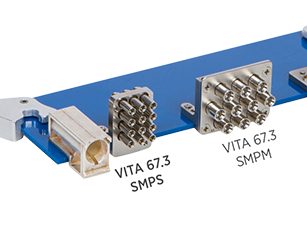VITA Standards Support RF/Microwave Backplane Solutions
The VITA 67 standards define the RF connector modules used in VPX architectures. Learn more about these important standards, including the latest, VITA 67.3.

Embedded computing is a critical part of many military and aerospace applications. Along with the proliferation of these applications, the VITA OpenVPX standards have also enjoyed growing popularity with increasing numbers of defense programs. The VITA 67 family of standards primarily serve high-reliability, high-density aerospace and defense applications that meet the vibration, environmental, and corrosion resistance requirements of VITA 47. The VITA 67 standard supports VPX embedded computing architecture and directs RF signals transmitted from Plug-In computing modules to a common backplane.

SV Microwave’s VITA Sample Chassis with 67.1 SMPM Modules and 67.3 (SMPM & SMPS).
The base VITA 67.0 standard was developed to provide a structure for implementing blind mate analog coaxial interconnects with VPX backplanes and Plug-In modules and define a specific family of interconnects and configurations within that structure. This provides several advantages. Standard products make it simple for operators to install, repair, and upgrade systems. Additionally, VITA 67 Plug-In connector modules are intermateable with backplane connector modules across multiple qualified manufacturers. (However, Plug-In connector modules must be populated by that manufacturer’s Plug-In contact.) Additional features arrived in subsequent updates: A four-position housing for VITA 67.1 and an eight-position housing for 67.2. VITA 67.3 is the most recent addition.

SV Microwave’s VITA Sample Chassis with 67.3 SMPS and SMPM modules
VITA 67.3 Overview
The VITA 67.3 specification draws on the solutions provided in 67.1 and 67.2 but is unique as it doesn’t define the locations of the ports like its predecessors. Additionally, floating contacts have been moved to the backplane side (versus the plug-in side in 67.1 and 67.2). These two changes were implemented to allow plug-in module designers the freedom to implement direct RF connector PCB launches on the carrier and/or any mezzanine card, eliminating the requirement for RF cable assemblies on the plug-in module. However, cable options are available and still permitted. Connector modules are designed with overarching VPX compliance in mind and are included in VITA 65 OpenVPX slot profiles. Fully populated modules are intermateable between all qualified manufacturers.

VITA 67.3 Connector Modules C, D, and E were developed to take advantage of the 1” pitch between adjacent plug-in modules. SV Microwave has created a variety of backplane connector modules (Module C example shown above).
SV offers a variety of SMPM plug-in connector modules and contact options as COTS parts.

To support design flexibility, increased data rates, and the high-density requirements of VPX platforms, SV Microwave has designed VITA 67.3 subminiature RF/coaxial modules for the SMPS series.
SV’s SMPS contacts are compatible with the DLA open standard. These contacts have either snap-in or flange-mounted features which are tightly pitched and stay aligned via precision holes in the Plug-In connector module.
SV is also capable of terminating VITA backplane cables in a number of different ways. SV has developed VITA modules that are terminated to a variety of multiport I/O panel solutions. Rather than cabling to individual I/O connectors, it is often advantageous to use a multiport I/O connector such as a D38999 circular or rectangular multiport for increased density and ruggedization. SV has also terminated SMPM Backplane connector Modules to Mini-D RF Bulkhead Mounts.
SV Microwave is an associate member of the OpenGroup and active participant of SOSA.
To learn more about VITA 67 solutions, visit Amphenol SV Microwave.
Visit Times Microwave to learn more.
Like this article? Check out our other Standards, RF and Coax, Harsh Environment and High-Reliability articles, our Mil/Aero Market Page articles, and 2021 Article Archives.
Subscribe to our weekly e-newsletters, follow us on LinkedIn, Twitter, and Facebook, and check out our eBook archives for more applicable, expert-informed connectivity content.





